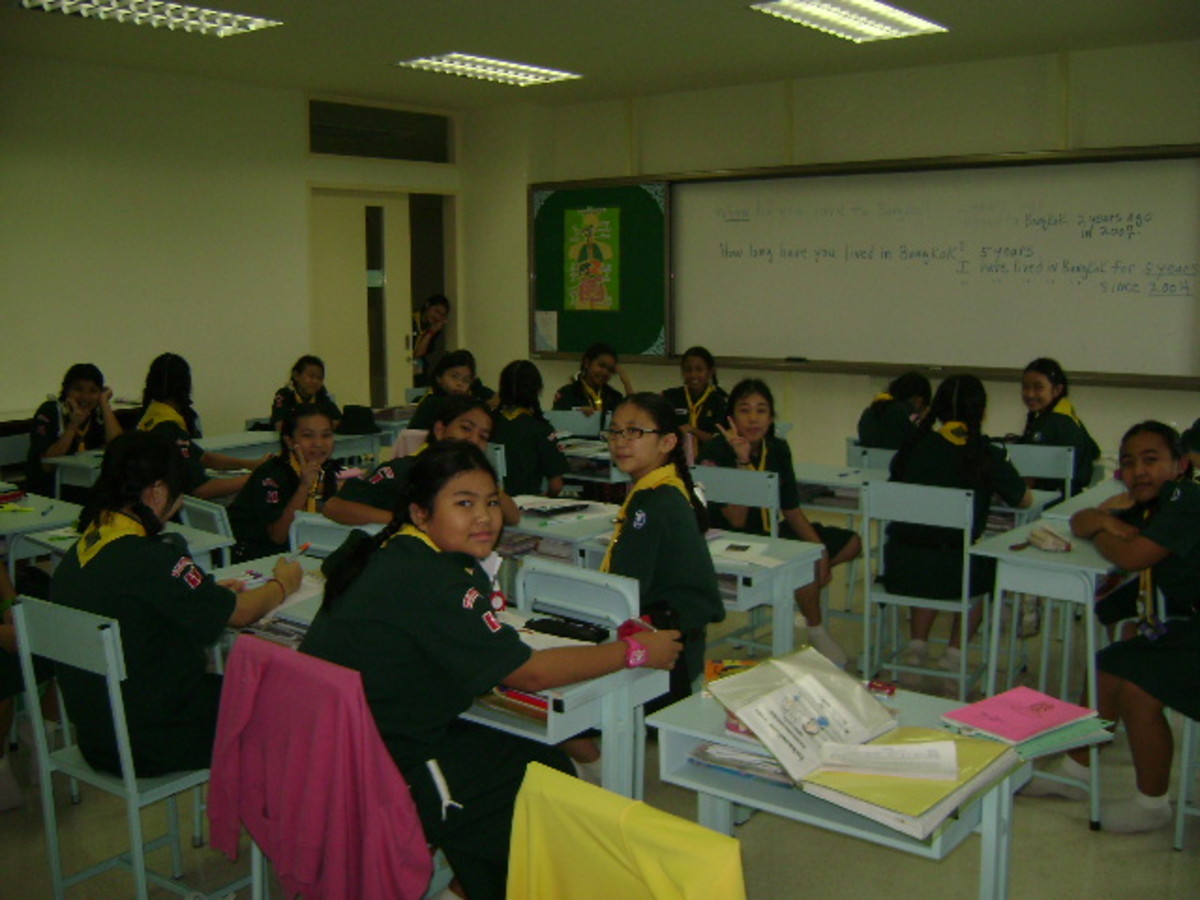A Guide to Teaching English as a Foreign Language
This is a brief guide to English Language Teaching. I've included some useful links at the bottom to help you find training and jobs.
What began in the 60's as a packpacker's way to earn a little extra cash along the way has grown into a major multi million dollar industry, from small private language schools to larger corporations with franchises and schools across different continents; businesses across the world are catering for large numbers of students. With the cultural and economic legacy of the British Empire followed by the economic and media dominance of the United States, English has become the lingua franca for business, academia and communication medias across the world. For the individual, it offers the opportunity to travel and to live in other countries across the globe, to discover the inside of cultures that would, otherwise, have been at a distance through tourist eyes.
Teaching English can land you in many different places and in many different situations; from a lecture hall shouting to 50 Chinese University students to a small office cubicle teaching spoken English to three Japanese housewives. I have been fortunate enough to have taught in London, Spain, Japan and Saudi Arabia and this has enriched my life no end.
Here's a quick glossary to some of the main teaching techniques, concepts and ideas you may find when beginning to explore the world of English language teaching.
Acronyms:
TESOL = Teaching English as a Second or Other Language
TEFL = Teaching English as a Foreign Language
The main difference here is the context. TESOL students will be those who have decided to settle in an English speaking country whereas TEFL students won't be.
TTT = teacher talk time STT= student talk time; ideally, STT should be high during a lesson and TTT should be low.
L1 = first language, usually used in the context of L1 interference where the native language of the speaker is interferring with the accuracy of the speaker's English, for example, Arabic speakers won't naturally use 'a' or 'the' because they don't have a direct equivalent.
IELTS = internationale English language testing system; "the world's leading test of English for higher education, immigration and employment. Education institutions, faculties, government agencies". The test produces a score from 0 to 9. Most educatoin institutions require a minimum score of around 5.5 to consider a non-native speaker of English for their courses
TOEIC = Test Of English for International Communication; this is the American equivalent of IELTS and performs much the same job.
Useful phrases:
False friends = a word that looks the same as a word in the student's native language but has a different meaning, for example, 'sympathetique' in French means nice but in English sympatheric has a different meaning.
Concept question = you can ask a student if he or she understands but this won't tell you if she does or not - you have to ask concept questions, so for example, if you wanted to check if a student understands the word 'apple', you could ask, 'Is it a vegetable', 'can you eat it?',' what colour is it',' does it grow in the ground?' etc
Elicitation = getting students to give you the answer. Instead of spoon feeding students information, teachers can ask questions to let the students tell you what they know. In doing so a teacher can gauge how much or little they know of a particular topic.
Warmer = a short fun exercise at the beginning of a lesson to engage the students and get them ready for study.
Nominated questions = this is when a teacher names a student to answer a question, often used to include more reticent students, or to check the learning of particular students you suspect haven't understood.
Cognitive engagement = this is where the teacher has managed to make the student think! If I tell you something it will enter your brain and leave it a little while later, if I question you and give you a problem this will make you think and if your brain has to work out a rule for itself it is much more likely to retain it. This is the opposite of spoon feeding.
Grammar = the way a language works, often presented by introducing students to the forms of a grammatical item and then to its function, for example, noun+s is the form for making regular nouns plural and the meaning is to indicate that the noun is plural.
Tenses = the time a verb is indicating i.e past, present or future
Simple tenses = an action that is complete
Continuous or progressive tenses = an action that is not complete
Perfect tenses = an action that connects one time period with another, e.g I have lived in New York for 10 years, this connects ten years ago when 'I' first moved to New York with now. This is probably the most conceptually elusive tense.
Subject = the noun that does the action. The boy kicked the ball - here the boy is the subject.
Object = the noun that has the action done to it. The boy kicked the ball - here the ball is the object.
Active tense = where the subject agrees with the verb. Sentences often take the basic form of subject verb object as in 'The boy kicked the ball'.
Passive tense = where the object agrees with the verb. We need to use the verb to be in whatever time we need together with the past participle. So to change The boy kicked the ball into a passive sentence we can lose the subject, the boy, because we're not interested in him anymore and replace him with the ball, so we get: The ball was kicked.
Modals = these are words such as can, could, should, would, might, ought etc that when we put them in front of the verb changes their meaning by including concepts such as possibility, obligation, ability etc. I go the doctor's is different from I could go to the doctor's or I should go to the doctor's or I might go to the doctor's...
Countable and uncountable nouns = strangely enough we can't count money but we can count dollars, cents, pounds and roubles etc. The acid test is if you can put a number in front of the noun and it make sense, it's a countable noun. So one money, two money doesn't make sense because we can't count money but one dollar, two dollars does make sense. The reason this is important is because it links into the uses of much and many, articles (a,an,the) and quantifiers (some, a few, a lot etc). We can say How much money but not How many money; we can say 'some money' but not 'a money'.
Nouns, verbs, adjectives, adverbs, prepositions, articles = these are the main labels given to words to identify their function. So nouns are names The thin MAN ran quickly, verbs are doing words The thin man RAN quickly., adjectives describe nouns The THIN man ran quickly, adverbs describe verbs The thin man ran QUICKLY. Prepositions link nouns to other words in a sentence e,g The book is ON the table. Articles are 'a','an' and 'the'. We use 'a' and 'an' to talk about a general example of something e.g A dog has four legs. We use 'the' to talk about a specific example, e.g The dog has three legs. In a narrative a noun is usually introduced to us using 'a' and thereafter it will appear with 'the' - A man walked into a bar. THE man asked for A beer. THE beer was cold.
How we speak:
Intonation: this is the rise and fall of the language, by our intonation we can communicate our emotions.
Stress timed = English is stressed timed, basically we accentuate different parts of words, for example we say ACCident not acciDENT. Over a sentence we accentuate the important words leaving a lot of words with weak form pronunciation, for example in 'I'm going for a week' the two important words are going and week, these are stressed, the other words use weak forms 'for' sounds more like 'fuh' and 'a' sounds like 'Uh'. Some other languages are syllable timed which is why speakers from other countries sometimes sound staccato or monotone.
Elision = where two words run into each other, much for the same reason as discussed above. An 'ice cream' sounds more like 'I scream' because of elision.
Contraction = where you see an apostrophe joining two words we have a contraction - so I am becomes I'm; I will becomes I'll; I do not becomes 'I don't' etc.
Teaching techniques:
Information gap = this is where an activity in the classroom is based on the fact that students have different pieces of information. The gap in information causes the need to communicate. A simple example maybe one student with a shopping list another with prices - communication can follow.
Gap fill - a traditional style of worksheet designed to test grammar and vocabulary. Students are asked to fill in missing words in sentences.
Controlled practice = an activity where the parameters are set by the teacher in order to steer the students towards practising a particular language point.
Authentic practice = an activity where, as far as possible, the students have the opportunity to practice their English in a real situation.
Role play = an activity where students act out a situation. This is often the culmination of all the previous lesson steps, so that students should be armed with all the grammar and vocabulary they need to successfully do the role play.
Find someone who / mingling activity = this is where students have to leave their chairs to complete an activity. They may, for example, have to 'Find someone who has been to Chicago' this will mean them walking around the classroom practising 'Have you been to Chicago?'. This activity can be as simple or as difficult as a teacher chooses.
Levels:
A false beginner is a student who appears to know next to nothing but actually has some latent knowledge that just needs to be retrieved to set them on their path, beginner is a basic level student, from here we have elementary, pre-intermediate, intermediate, upper intermediate, advanced and proficiency levels. These levels are fairly standard in most private language schools but there are other systems afoot in the world.
Publishing:
If you make it a career there are progression routes into teacher training and publishing.
Headway = possibly the most famous English language textbook. Check out the links below for getting qualified and finding a job:
Hopefully, this gives a taste of English Language teaching.
Helpful links
- Saxoncourt | English | Language | Teacher | Training | Recruitment | Jobs|| CELTA Courses
Saxoncourt is a world leader in training, recruiting and placing English teachers. Our consultancy is responsible for placing over 600 English teachers with private language schools in up to 20 different countries every year. - International House London | Language School, English Courses, Modern Languages, Teacher Training, B
Long-established language school, International House London, provides English Language Courses, Teacher Training, Business English and Modern Languages in the heart of London. - Welcome - TEFL.com
TEFL.com - The world's largest real-time database of English Language Teaching Jobs - Teacher Recruitment - British Council
- Headway
The official Oxford University Press ELT website provides information and resources for ELT teachers, students, and professionals worldwide, including a detailed catalogue, The Oxford Teachers' Club for teaching resources, Student's Sites with exerci








